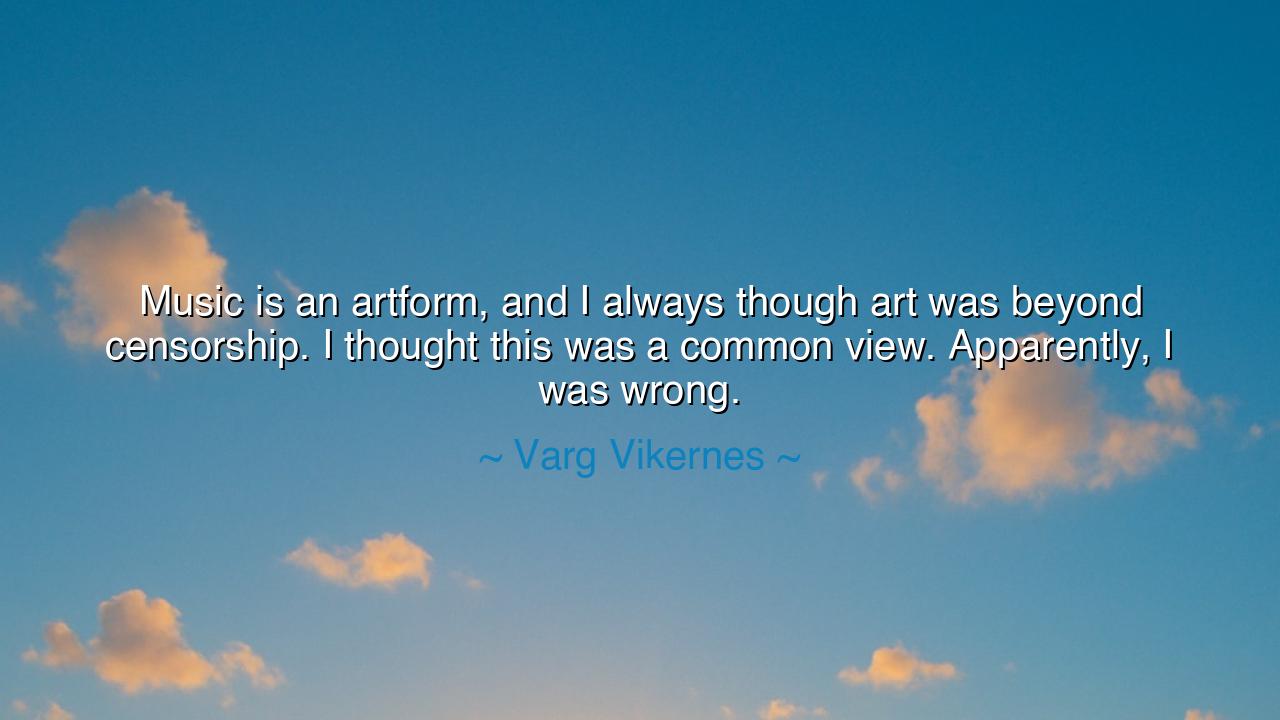
Music is an artform, and I always though art was beyond
Music is an artform, and I always though art was beyond censorship. I thought this was a common view. Apparently, I was wrong.






The words of Varg Vikernes strike with the resonance of defiance and disillusionment: “Music is an artform, and I always thought art was beyond censorship. I thought this was a common view. Apparently, I was wrong.” In these words is carried the ancient struggle between the free spirit of creation and the binding chains of authority. For music, that most primal of arts, is not merely sound but soul; it is the cry of humanity itself, older than the written word, deeper than the spoken tongue. To silence it, to bind it, is to attempt to shackle the wind or darken the sun. Yet across history, rulers and societies alike have tried, fearing the power that unfettered art can awaken.
From the dawn of time, the ancients saw that art was the voice of truth. The poets of Greece sang songs that stirred the heart and questioned the order of men. The dramatists of Athens wrote plays that unveiled corruption and mocked kings. And what did the mighty do? They censored, they punished, they sought to silence. Yet the words endured, carved in memory, passed from tongue to tongue, because art was beyond censorship, even if its creators were not. Vikernes’s lament reminds us that even in modern ages, the struggle remains: the world still trembles before art that speaks too boldly.
Consider the tale of Socrates, though not a musician but a philosopher, whose teachings were themselves a form of art. He questioned, he provoked, he sought truth beyond convention. The rulers of Athens accused him of corrupting the youth, of spreading dangerous ideas. And so they condemned him to drink the hemlock. Yet though his voice was silenced, his teachings did not die; they blossomed in the works of Plato and Aristotle, shaping all Western thought. Here is the paradox: the attempt at censorship only magnified the power of the art. What was meant to be destroyed became immortal.
The music of resistance has always borne this fate. Think of the songs of enslaved peoples in the Americas, whose rhythms carried sorrow, hope, and secret messages of escape. Their oppressors tried to suppress them, fearing the unity and strength they inspired. Yet those songs endured, shaping blues, gospel, and jazz—artforms that would one day speak to the entire world. So too in every age: tyrants may fear the pen, the brush, the lyre, or the guitar, but their fear proves only the strength of the creation. For art is the fire they cannot quench.
Yet Vikernes admits another truth: “Apparently, I was wrong.” For while art itself may transcend censorship, the artist often does not. The world is filled with misunderstanding, fear, and power that seeks to control expression. The dream that art would always be free is noble, but the reality is harsher. This is the lesson the ancients knew well: freedom must be fought for, defended, and carried, generation after generation. Without vigilance, even the most sacred art can be stifled, twisted, or erased.
From this reflection emerges a teaching for all who create: do not cease your voice, even if it is threatened. The worth of art is not measured by the comfort it brings to rulers, but by the truth it bears to the people. Yet also, be wise—choose the ways in which your art may endure. If your words are silenced in one form, let them live in another. If one path is closed, carve another. The true artist is not merely a dreamer but a warrior, ensuring that their flame burns beyond the reach of censors.
Therefore, O listener, guard your art and your voice. If you write, write boldly. If you sing, sing with fire. If you paint, let your colors reveal the depths of your soul. And if you face resistance, remember that this has always been the path of the artist. To stir the world is to invite its resistance. Yet in that very resistance, your power is revealed. For though men may silence a singer, they cannot silence the song once it has entered the hearts of the people.
Thus, take this as your lesson: art is sacred, and its freedom is not guaranteed but must be preserved. Stand as the ancients stood, with courage and devotion. Let your work be honest, fearless, and enduring. For in every age, there will be those who try to bind the spirit of creation. And in every age, it is the task of the artist to prove that spirit unbreakable.






AAdministratorAdministrator
Welcome, honored guests. Please leave a comment, we will respond soon